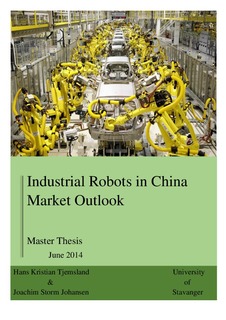| dc.contributor.author | Johansen, Joachim Storm | |
| dc.contributor.author | Tjemsland, Hans Kristian | |
| dc.date.accessioned | 2014-09-03T09:11:38Z | |
| dc.date.available | 2014-09-03T09:11:38Z | |
| dc.date.issued | 2014-06-15 | |
| dc.identifier.uri | http://hdl.handle.net/11250/218637 | |
| dc.description | Master's thesis in Finance | nb_NO |
| dc.description.abstract | This thesis investigates the future development of industrial robots in China. It will focus on growth in robot sales toward China and try to identify which companies that are most capable of benefiting from the potential growth. A triangulation approach is applied, where both qualitative and quantitative methods is utilized. SWOT, discrete data and panel data analysis supports our conclusion about a strong growth in China. Porter`s Five Forces and financial analysis have pointed out interesting companies relative to China, such as the German based company KUKA. The thesis uses interviews as a source to qualitative information, adding firsthand business knowledge about the subject. In addition, quantitative data have been collected from The International Federation of Robotics and Morgan Stanley research department.
From 2005-2013 the robot sale in China has increased with a compounded annual growth rate of 30%. The key result suggests that the current situation in China indicates a promising future growth of industrial robots. The growth potential in China is a direct consequence of the small robot density in the country, compared to other industrialized countries. China is a manufacturing –based and export-oriented economy. Modernization of the manufacturing sector in China needs flexibility and effectivity upgrades. The aging population together with rising wages are necessitating automation of production processes. The tremendous growth experienced in the automobile industry intensifying the opportunity to robotize. The automotive industry has the highest density of industrial robots.
The thesis also concludes that domestic robot producers and the foreign company KUKA should experience a rapid growth in sales as a consequence of the growth in the Chinese market. Further analysis on domestic companies is required to explore potential domestic investment objects.
Key words: Industrial robots, robot density, China, ageing population, rising wages, motor vehicle production, KUKA, SWOT, Panel Data, Porter`s Five Forces | nb_NO |
| dc.language.iso | eng | nb_NO |
| dc.publisher | University of Stavanger, Norway | nb_NO |
| dc.relation.ispartofseries | Masteroppgave/UIS-SV-HH/2014; | |
| dc.rights | Attribution-NonCommercial-NoDerivs 3.0 Norway | * |
| dc.rights.uri | http://creativecommons.org/licenses/by-nc-nd/3.0/no/ | * |
| dc.subject | industrirobot | nb_NO |
| dc.subject | Kina | nb_NO |
| dc.subject | økonomi | nb_NO |
| dc.subject | swot | nb_NO |
| dc.subject | finans | nb_NO |
| dc.subject | bilproduksjon | nb_NO |
| dc.subject | panel data | nb_NO |
| dc.subject | anvendt finans | nb_NO |
| dc.title | Industrial robots in China | nb_NO |
| dc.title.alternative | Industriroboter i Kina | nb_NO |
| dc.type | Master thesis | nb_NO |
| dc.subject.nsi | VDP::Social science: 200::Economics: 210::Business: 213 | nb_NO |

